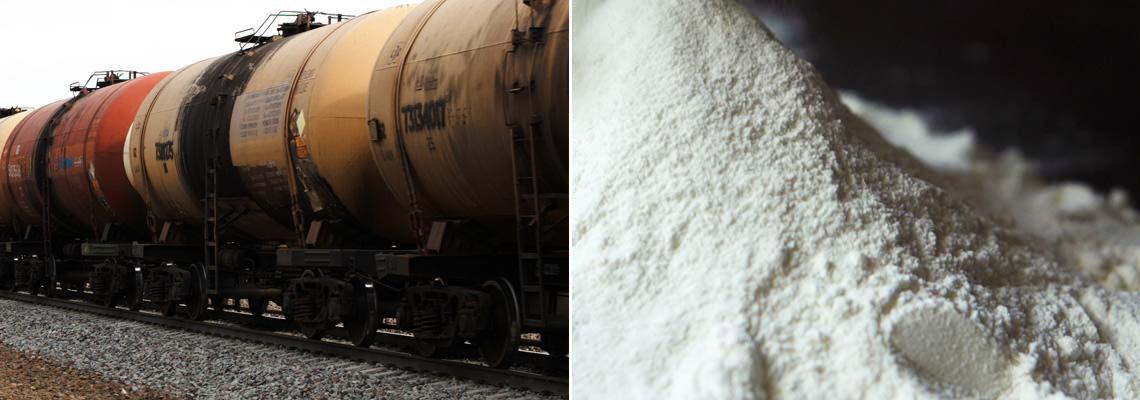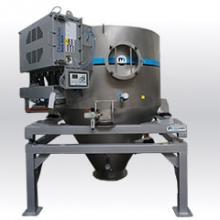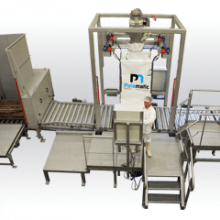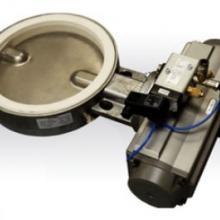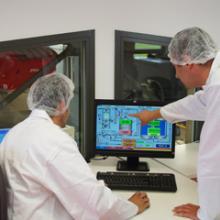Processed powders: tapioca starch, potato starch, corn starch
Railcar unloading
Our client, located in northwest Indiana, is a local waste management facility. In order to recycle certain materials, they were investigating a new process that would allow them to unload tanker cars filled with various starches including: tapioca starch, potato starch, corn starch, etc. However, these starches were not purposed for food production but it was industrial food waste. The waste materials would be recycled and re-purposed into binding agents for items such as wood pellets. This was a new process for our client; therefore, they needed the professional guidance of our powder and bulk material experts to help design a system that would repackage the waste starches for resale.
1. Rail car unloading system and pneumatic conveying
The first step of this process was getting the starch out of the rail car in a controlled and contained manner. To do so, a vacuum conveying system with a cyclo-splitter was the selected transfer method. The throughput rate of the system would perform at 6 tons per hour of output. The rate was calculated based on the daily production goal and shift cycles. With 8-hour work shifts per day, the goal was to fully unload 80-90 tons of starch powder in 2 days. Because starch is considered a combustible dust, the equipment needed to meet NFPA hazardous location requirements of classification 2, division 2.
Also, the system was installed outdoors with a lean-to structure to shield the equipment from rain and snow. However, the site was near a coastal area with concerns of high humidity and rusting. The selected material of construction was 304 stainless steel. Although not a food process, 304SS offers excellent rust and mild corrosion resistance. The flexible conveying connection line hooked up to a camlock for vacuuming the bulk material from the bottom outlet connection of the rail car. As material is mixed with air, it is conveyed to the cyclone via high velocity caused by the vacuum pump. There, the material enters the cyclone body and spins in a downward spiral collecting at the bottom. The air is separated through a filter system and clean air is exhausted through the vacuum pump. A reverse pulse jet cleaning system sends blasts of clean air through the filters to unclog them.
2. Big Bag Filling System
In order to repack the starches for resale to end markets, a big bag filling station FlowMatic® 04 is positioned under the cyclone. A butterfly valve isolates the cyclone from the big bag filling unit. As the high-level probe indicates when the cyclone is full, it releases the material into the big bag filler. To help contain dust and any potential material spillage, an inflatable valve seals around the inside of the big bag inlet spout. The double jacketed filling head allows material to enter the big bag while the air volume is safely displaced through the outer jacket and exits through a filter sock.
The pneumatic cylinder helps raise and lower the big bag during its filling to help optimally shape the bottom of the FIBC. A vibrating densification table helps deaerate and stabilize the material in the big bag for optimal packing. Load cells give feedback to our control panel to tell the equipment when to shut down the conveying system once the big bag has reached its max fill volume by weight. A label printer prints a label to attach to the big bag for weight verification, package date, batch number, etc.
The system is fed with an automated pallet feeder and motorized roller conveyor. Once filled, the seal deflates and the hooks release the handles. The operator ties the spout and the conveyor moves the filled big bag on its pallet to a buffer area for a forklift operator to move it to a temporary storage area for final transport.
The big bag filling station is capable of filling up to 10 big bags per hour, however this production system was able to meet the production rate of 8 tons per hour with ease. All components are design for the designated ATEX rating of Class 2 / Div 2. The touch screen control panel allows the operator to control all parts of the system with ease.














